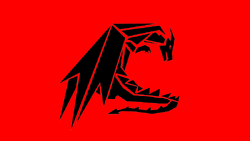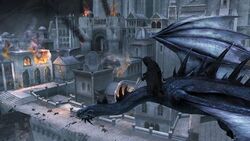| Kurema | |
|---|---|
 Motto: To the skies with heart National Anthem: "The Protector's Wings" | |

| |
| Capital | Nagburg |
| Largest City | Nagburg |
| Official Language(s) | Common |
| Demonym | Kureman |
| Government | Constitutional monarchy Federal republic |
| Emperor | Unknown |
| Prime Minister | Unknown |
| Legislature | Congress |
| Sovereignty | Rebels exiled from Sengetsu |
| Currency | Kureman Dollar (KMD) |
| Country Code | KM |
- This article is about the present-day nation. For the Kureman empire, see Empire of Kurema.
Kurema (クレマ; Kurema) was a militaristic nation on the Higashi continent and a member-state of the Higashi Treaty Organization (HTO). The earliest known settlers of Kurema were exiles from the aftermath of a civil war against Sengetsu, fleeing south to avoid post-war retribution. War and conflict extensively marked Kurema's history, having played a major role in the formation of the country. Despite living in a constant struggle against the local wyvern population, the first Kureman settlers managed to tame several of them for use. This eventually led to the wyvern being the cavalry mount of choice and symbol of the Kureman military. Kureman is used to label a citizen or object from Kurema.
History[]
Colonization[]
The first Kuremans originated from Sengetsu in the aftermath of the Sengetsu Civil War. They fled from their homeland after a disastrous defeat in AD 263 and retreated to the rugged and dangerous mountain ranges to the south, where they made their home with wild wyverns. The settlers eventually began taming these wyverns for use in self-defense against raiders and other outsiders. This act of defense eventually developed into a business, allowing the land, soon called Kurema, to prosper. However, wyvern attacks on local villages made the Kuremans realize that working just for their own survival would wipe them out.
The first government was a confederation between a multitude of villagers, though its lack of central authority made the government ineffective at achieving its original purpose of uniting the Kureman people for defensive purposes. Otso Wuopio took it upon himself to toss aside the old Kureman Confederation, and reformed the nation into the Kingdom of Kurema. Thorne named himself the First Emperor of Kurema, becoming the central authority that the confederate government lacked prior to Thorne's reforms.
However, Wuopio's governmental reforms faced enormous criticism, with those in opposition to the reform to a imperial government wanting to reform the nation into a government akin to a federal republic. Fights broke out in the streets between the so-called Royalists, those loyal to Wuopio, and the Republicans, who supported a republican government.
The Kureman Civil War[]
- Main article: Kureman Civil War

A member of the Imperial Guard surveys the damage left in Korburg.
The fights turned from fist fights to bloody conflicts rather quickly. The civil war last for years, as both sides were almost equally matched in terms of generals and dedicated followers. Wuopio attempted to quell the rebellion to the monarchal rule and brand those who believed in the republican cause as traitors, which worked poorly to dissuade people from turning to the republicans.
Wuopio crushed the government forces and consolidated power into the Imperial throne. He became known as the Demon Lord for his merciless acts during the coup, though his dark deeds appear to be limited to only the civil war itself. Eventually one of his descendants, Emperor Ilyas broke the centralized power into three main regions, each with their own administrative bodies that answer to him. This streamlined the administrative process, enabling Kurema to focus on technological advancements in the 18th century.
Modernization[]

Nagburg, the national capital, during the Industrial Revolution.
- Main article: Industrial Revolution
The Industrial Revolution marked the advent of the modernization of technology. The Kureman imperial family saw it crucial to not fall behind in technology in order to not be swallowed up by other nations who are advancing their own technology. As a result, the Kureman military grew in power, especially the air force. The advances in military aircraft were so drastic, the traditional wyvern cavalries were effectively phased out for mechanical war planes in a matter of decades.
The effects of the Industrial Revolution are still felt in the Kureman armed forces, with their incredible progress making the country a formidable military power. The geographical location of Kurema in the middle of the Higashi continent made Kurema's armed forces even more fearsome, since they can launch a massive offensive in minimal amounts of time anywhere on the continent.
Modernization[]
As time progressed, the Kureman empire came under pressure from tight relations with its neighboring countries. Among the criticism that Kurema faced was its ever growing military power, and the potential for its abuse to blackmail and bully other countries. Internal dissidence regarding the policies of the Imperial family eventually led to minor conflicts that were only concluded with the signing of the Treaty of a Unified Empire in AD 1945, transforming Kurema into a federal republic with a constitutional monarchy.
Also at this time, Kurema announced that they have discovered the means to theoretically create an artificial weaver. Despite this, scientists state that they have only tested this on animal subjects and that there is no confirmation that the procedure would work for sentient beings.
Weaver Crisis[]
- Main article: Weaver Crisis
Geography[]
Mountainous and rugged were common adjectives used to describe Kureman terrain. The difficulty of travel by foot quickly made the use of wyvern mounts the preferred form of travel by Kureman citizens for centuries. The most plains-like region of Kurema could be found at the Kureman Plains, situated near the center of the country. The capital, Nagburg, could be located at the southern edge of the region, its location chosen for its strategic military advantages.
As time progressed, roads became more viable means of travel due to the rising cost of oil. Millions of dollars were poured into improving infrastructure with the creation of highway systems.
Government and politics[]
Kurema was previously ruled by a monarchy, though it has since gradually shifted to a constitutional monarchy with a democratic system in place to elect political leaders. The change in power was peaceful since a lesser version of the system was already being practiced during Emperor Jokela's rule. As time progressed, Kurema's military advancements have slowed, as the country began favoring more peaceful diplomatic solutions to issues as a member of the Higashi Treaty Organization. However, a sect of ultra-nationalists want to bring Kurema back to its bloody military roots and remind the rest of the world of the power of the Kureman armed forces.
Controversy[]
For years, Kurema's large military, its air force in particular, has been criticized by the HTO as expanding too rapidly, alongside its wide power projection capabilities. Kurema has insisted that the military has been a significant part of Kureman culture, only going as far as to limit the production of Kureman arms. The country also was confronted with questions regarding the nature of its research and experiments. Kurema reassured the international community that no amoral acts were being performed in government-funded experiments.
Economy[]
- Main article: Economy of Kurema
Kurema is a state capitalist mixed economy that focuses on exporting finished products. Under the state capitalist system, the Kureman government only holds shares in companies that comprise 60% of its GDP through government-owned investment funds. Its currency is the Kureman dollar (KMD), used exclusively in the country. From its military background, the Kureman economy has focused heavily on keeping a low unemployment rate, from the militaristic belief that a maximum output boosts Kureman war operations, contributing to a lower than average unemployment rate than many other countries, at 4%. Kurema has a tax rate of 34%.
Religion[]
- Main article: Valkoi
Kurema is officially a secular state, though their indigenous religion is called Valkoi. Valkoi is centered around the belief of cleansing. Rituals play an enormous role within the Valkoi tradition, with a typical follower performing as many as six rituals in a day. Prayers were conducted individually or in small groups at Valkoi shrines. These shrines' rituals vary among themselves, in accordance to the time of day, time of year, as well as whether the shrine was dedicated to the sun or moons. Even among shrines of the same dedication, rituals may have slight differ depending on the regional influence, originating from the former nomad lifestyle of the Kuremans.
Before traveling considerable distance, such as between towns, it was customary to perform a ritual prayer for good luck, as well as a prayer of thanks afterward to ensure that the next long-distance travel would be as successful, if not more. Water plays a significant role in a plethora of Valkoi rituals, dubbed water rituals.
Culture[]
The elders were highly respected in Kureman culture, as they had greater experience and supposed wisdom than the others. Also, since vegetation were scarce, they were usually presented with walking sticks before the younger people could use them. As technology progressed, the walking stick grew to become a ceremonial object, and was considered a gracious gift symbolizing one's hope for a safe journey.
The wyvern symbolized the harshness of the wilderness in traditional Kureman arts, as well as the strong desire to protect others from harm. This is because of the old threat of wild wyverns and the later taming of wyverns for use in public militias.
Military[]

KIAF H-08 Dragons (now a retired aircraft) in action.
- Main article: Kureman armed forces
Kurema focused heavily on air superiority since its founding. Its array of air superiority fighters, bombers, UAVs, and other aircraft are considered to be the most technologically advanced in the world; the result of years of government-funded research and development. The Kureman Imperial Air Force (KIAF) is among the most feared forces in the world.
Even its navy centers itself around the air force: the Kureman Navy prides itself in its heavily armed aircraft carriers, including a supercarrier, though they are not afraid to utilize destroyers, battleships, frigates and other warships. However, Kureman warships are somewhat lacking, performance-wise, in comparison to other national naval forces.
The Kureman Army, on the other hand, concentrates its strength in guerilla warfare. They place strong emphasis on the use of artillery and long-range gun emplacements. Information supplied to them by scout craft from the KIAF allows the Army to initiate precision strikes against distant targets. However, the army was capable of meeting other conventional forces in direct combat, especially in the mountainous regions where their familiarity with the rugged terrain allows them to effectively fend of enemy assaults.
Notable locations[]
- Nagburg is the capital of the Nagant Province of Kurema, as well as the capital of the nation.
- Korburg is the capital of the Korkant Province, found in the northern regions of Kurema.
- Suoburg is the capital of the Suant Province, located in the southern regions of Kurema.
Behind the scenes[]
Kurema is derived from the Finnish words that mean "dragon land".
The country of Kurema was originally created as a role-played nation in a fantasy-based nation simulation.